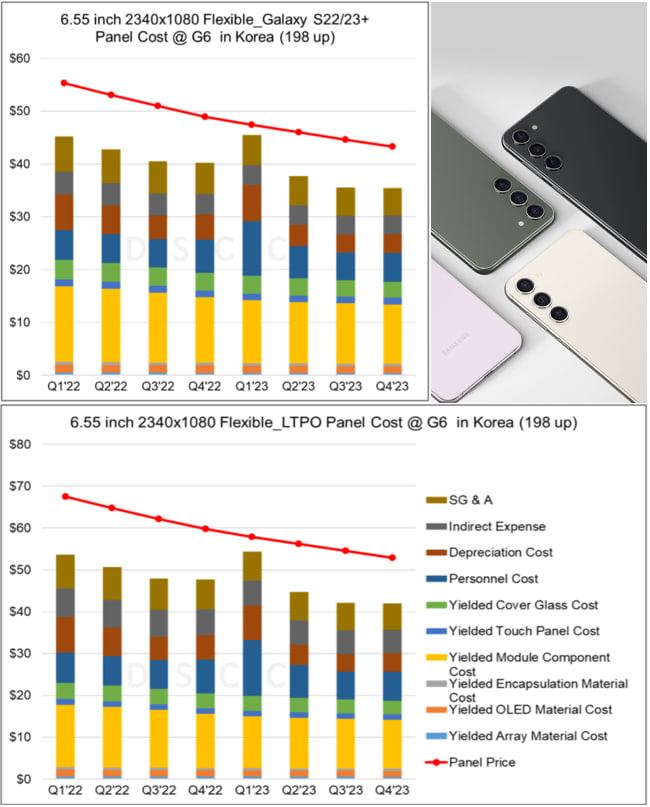News
Samsung LTPO display would have made Galaxy S22/S23 Plus more pricey

The Galaxy S22 Plus and Galaxy S23 Plus would have been $8 to $10 more pricey if Samsung had applied LTPO OLED display. Recently, market research firm DSCC revealed the cost and price increase if Samsung D applied LTPO TFT instead of LTPS TFT display to the Galaxy S22 Plus and S23 Plus.
According to estimation based on research, the Galaxy S22 Plus and S23 Plus’ LTPO display production cost difference is $8 and the price increase was likely to reach $10. The estimation is predicted if the company applied LTPO TFT instead of LTPS TFT to a 6.55-inch panel.
LTPO
For starters, the Galaxy S23 Plus and last year’s Galaxy S22 Plus come with LTPS (low-temperature polycrystalline silicon) TFT display panel. Compared to LTPS TFT, the cost of LTPO TFT rises because of the addition of the oxide process.
In easy words, the LTPO panel is more power efficient than the LTPS panel as it supports a variable refresh rate of 1Hz to 120Hz. The latest Galaxy S23 Ultra features 1Hz to 120Hz variable display refresh rate along with Apple’s iPhone 14 Pro and Pro Max.
OLED production
As per DSCC estimation, the Galaxy S22 Plus LTPS display cost, which was in the mid-$40 range in the first quarter of last year, fell to $40 in the fourth quarter. However, it rose to the mid-$40 level again in the first quarter of this year.
On the flip side, the OLED production cost for the Galaxy S23 Plus could fall to the mid-$30 in the second quarter of this year. From the first quarter of last year to the fourth quarter of this year, the price of the panel has been continuously declining.

Samsung D is far ahead
Although the OLED production yield of Chinese panel makers has increased, they are still lagging behind Samsung Display even in relatively simple OLED mass production. Based on 6.5-inch FHD+ rigid OLED, Samsungs yield in Q2 2023 is expected to record 94%, 4% more than Chinese panel makers.
Securing OLED profitability is also a challenge for Chinese panel makers. The price of a 6.5-inch FHD+ (2400×1080) LTPS liquid crystal display (LCD) panel is $4 lower than OLED of the same size and resolution, but the cost of an LCD is $10 lower than that of OLED.
News
Forbes: Samsung’s Jay Y. Lee is the richest Korean in 2024

Samsung’s executive chairman Jay Y. Lee (Lee Jae-yong in Korean) topped the Forbes 2024 Richest Korean list for the first time. On April 17, Forbes revealed that the Samsung boss is the richest in South Korea, with his assets increasing by $3.5 billion, bringing his total net worth to $11.5 billion.
Thanks to a rise in Samsung’s stocks, Samsung’s Lee jumped to the top of the Forbes 2024 Richest Korean list. Notably, the company’s stocks significantly hiked after the revelation that it’s developing high-bandwidth memory chips used in AI computing for NVIDIA.
Forbes 2023 Richest Korean, Kim Byung-ju, slipped to second this year with assets worth $9.7 billion. The third place went to Seo Jung-jin, honorary chairman of Celltrion, with assets of $7.5 billion.
Cho Jung-ho, chairman of Meritz Financial Group, ranked fourth with $6.2 billion, and Chung Mong-koo, honorary chairman of Hyundai Motor Group, was fifth with $4.6 billion.

Stay up-to-date on Samsung Galaxy, One UI & Tech Stuffs by following Sammy Fans on X/Twitter. You can also discover the latest news, polls, reviews, and new features for Samsung & Google Apps, Galaxy Phones, and the One UI/Android operating system.
Do you like this post? Kindly, let us know on X/Twitter: we love hearing your feedback! If you prefer using other social platforms besides X, follow/join us on Google News, Facebook, and Telegram.
News
Samsung builds AI-focussed Advanced Processor Lab in the US
Samsung established an AI chip design-dedicated Advanced Processor Lab in Silicon Valley, US. Formerly known as the Advanced Institute of Technology, Samsung’s SAIT is said to have formed the new Lab to strengthen its AI chip R&D in the US.
BusinessKorea reports that the new Samsung Advanced Processor Lab to focus on developing next-gen AI semiconductor design assets in the US. The assets are said to be focused on the RISC-V area, which serves as a foundational design asset for semiconductor chip design.
Samsung’s initiative with RISC-V is interpreted as a move towards technological independence. Therefore, the company is expanding its R&D organization in Silicon Valley, aiming to enhance design capabilities to disrupt the market currently dominated by NVIDIA.
Amid the booming AI era, the market of advanced semiconductors is also expanding. Samsung has completed the development of its Mach-1 AI semiconductor and supplied prototypes to global firms including Korea’s Naver. The company has also started the development of Mach-2.
Under the CHIPS Act, Samsung received huge subsidies to boost investment in the US. It’s worth noting that the Biden govt awarded a 12% subsidy of Samsung’s total investment, which is significantly higher than Intel and TSMC’s subsidy.
Stay up-to-date on Samsung Galaxy, One UI & Tech Stuffs by following Sammy Fans on X/Twitter. You can also discover the latest news, polls, reviews, and new features for Samsung & Google Apps, Galaxy Phones, and the One UI/Android operating system.
Do you like this post? Kindly, let us know on X/Twitter: we love hearing your feedback! If you prefer using other social platforms besides X, follow/join us on Google News, Facebook, and Telegram.
News
Samsung Galaxy S25’s 3nm Exynos 2500 to beat Snapdragon 8 Gen 4 in power efficiency

Samsung’s first 3nm Exynos 2500 chip could outpace Snapdragon 8 Gen 4 in power efficiency. Both chipsets will power the next-gen Galaxy flagships, scheduled for an early 2025 launch. Recent input suggests that Exynos is returning as a tough rival to Snapdragon.
The Exynos 2500 will be made on Samsung’s 2nd-gen 3nm process technology. The S24’s Exynos 2400 chipset impressed the industry with significant improvements over its predecessor. The company appears to be leveling up the game next year.
Thanks to the cutting-edge process node, Samsung’s next Exynos could finally surpass its Snapdragon counterpart in power efficiency. The company may utilize its advanced FOWLP in the Exynos 2500 to make it run at higher clock speeds at the same power consumption level.
Qualcomm is facing power efficiency concerns with its recent Snapdragon chips. Due to reduced efficiency, phone makers are forced to bring up to 5000mAh battery. Samsung apparently seized this opportunity to bring back its in-house Exynos back to the contest.
Stay up-to-date on Samsung Galaxy, One UI & Tech Stuffs by following Sammy Fans on X/Twitter. You can also discover the latest news, polls, reviews, and new features for Samsung & Google Apps, Galaxy Phones, and the One UI/Android operating system.
Do you like this post? Kindly, let us know on X/Twitter: we love hearing your feedback! If you prefer using other social platforms besides X, follow/join us on Google News, Facebook, and Telegram.










